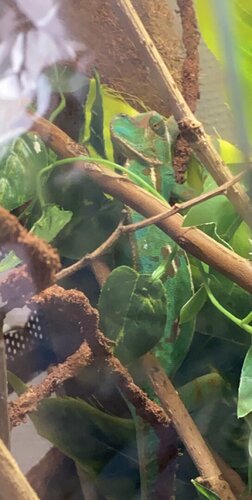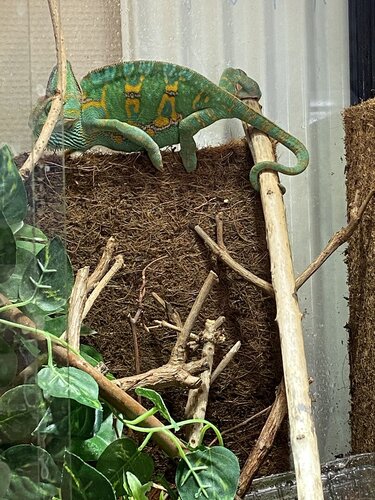malle000999
Member
Just got my Cham but she's still super dark green when I approach her. What can I do? I got her 2 days ago she lives in her old cage because I don't know when to transfer her to the new cage, she's just so stressed after the hole transferring. I don't think she knows how to drink from her dripper because she had a diffrent watering system before I got her.
When I'm in the room she does not take her eyes off me.
I won't be in the room for hours just to give her some privacy.
I am not going to handle her for a long time I'm just too scared because of the hissing.
Info:
Species: Vailed chameleon
Age: 9 month
Gender: female
had her In my care: 2 days
Food: she eat about 6-7 grasshoppers per day
Light and heat: She has an HID light and the temp is about 23 degrees
I spray her every morning, doing the day, and before she needs to sleep also her plants about 3-4 times a day.
She's in a glass cage but I'm transferring her to a net cage.
She has a dripper and I turn it on every 2 hours for about 30 min.
She won't eat when I'm around or move.
She tried to get ready for battle with taking out her double chin and turning bright green with yellow dots, she have been hissing at me.
I'm from Denmark so sorry for my English.
When I'm in the room she does not take her eyes off me.
I won't be in the room for hours just to give her some privacy.
I am not going to handle her for a long time I'm just too scared because of the hissing.
Info:
Species: Vailed chameleon
Age: 9 month
Gender: female
had her In my care: 2 days
Food: she eat about 6-7 grasshoppers per day
Light and heat: She has an HID light and the temp is about 23 degrees
I spray her every morning, doing the day, and before she needs to sleep also her plants about 3-4 times a day.
She's in a glass cage but I'm transferring her to a net cage.
She has a dripper and I turn it on every 2 hours for about 30 min.
She won't eat when I'm around or move.
She tried to get ready for battle with taking out her double chin and turning bright green with yellow dots, she have been hissing at me.
I'm from Denmark so sorry for my English.



